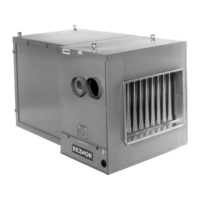Revision: I-SCE (09-18) PN207697R9
SEPARATED-COMBUSTION,
PACKAGED FURNACE/BLOWER,
MODEL SCE
INSTALLATION/OPERATION/MAINTENANCE
⚠ WARNING ⚠
FIRE OR EXPLOSION HAZARD
• Failure to follow safety warnings exactly could result in serious injury, death, or
property damage.
• Be sure to read and understand the installation, operation, and service instructions
in this manual.
• Improper installation, adjustment, alteration, service, or maintenance can cause serious
injury, death, or property damage.
Do not store or use gasoline or other flammable vapors and liquids in the vicinity of
this or any other appliance.
WHAT TO DO IF YOU SMELL GAS
• Do not try to light any appliance.
• Do not touch any electrical switch; do not use any phone in your building.
• Leave the building immediately.
• Immediately call your gas supplier from a phone remote from the building. Follow the
gas suppliers instructions.
• If you cannot reach your gas supplier, call the fire department.
Installation and service must be performed by a qualified installer, service agency, or
the gas supplier.
DO NOT DESTROY. PLEASE READ CAREFULLY. KEEP IN A SAFE PLACE FOR FUTURE REFERENCE.
Supersedes: I-SCE (5-15) PN207697Rev8
TABLE OF CONTENTS
IMPORTANT SAFETY INFORMATION .................................................................. 2
GENERAL INFORMATION ............................................................................ 3
Installation Codes ................................................................................. 3
Special Installations (Aircraft Hangars/Garages) .......................................................... 3
Warranty ........................................................................................ 4
INSTALLATION ..................................................................................... 4
Dimensions ...................................................................................... 4
Uncrating/Unpacking ............................................................................... 5
Clearances ....................................................................................... 6
Location ......................................................................................... 6
Weights ......................................................................................... 6
Suspension ...................................................................................... 6
Mounting ........................................................................................ 7


